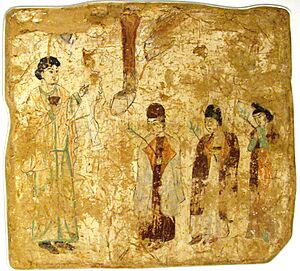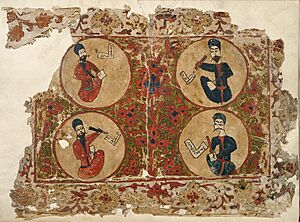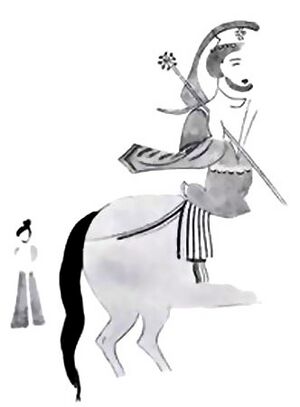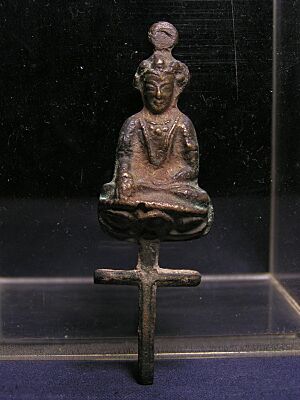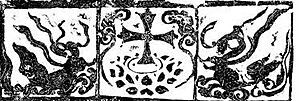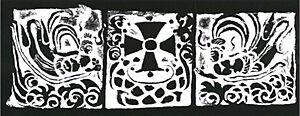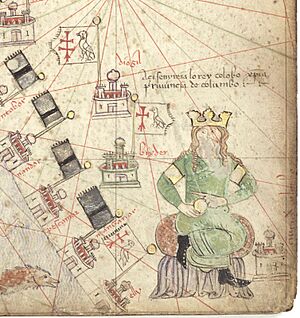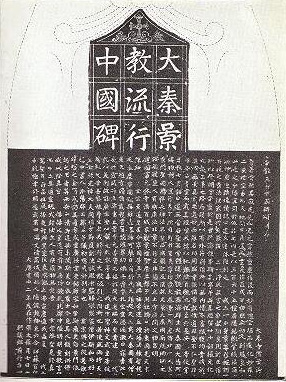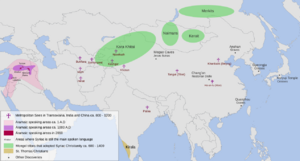Church of the East facts for kids
Quick facts for kids Church of the East |
|
|---|---|
| ܥܕܬܐ ܕܡܕܢܚܐ | |

|
|
| Type | Eastern Christian |
| Orientation | Syriac Christianity |
| Theology | East Syriac Theology |
| Polity | Episcopal |
| Head | Catholicos-Patriarch of the East |
| Region | Middle East, Central Asia, Far East, India |
| Liturgy | East Syriac Rite (Liturgy of Addai and Mari) |
| Headquarters | Seleucia-Ctesiphon (410–775) Baghdad (775–1317) |
| Founder | Jesus Christ by sacred tradition Thomas the Apostle |
| Origin | Apostolic Age, by its tradition Edessa, Mesopotamia |
| Branched from | Nicene Christianity |
| Separations | Its schism of 1552 divided it originally into two patriarchates, and later four, but by 1830 it returned to two, one of which is now the Chaldean Catholic Church, while the other sect split further in 1968 into the Assyrian Church of the East and the Ancient Church of the East. |
| Other name(s) | Nestorian Church, Persian Church, East Syrian Church, Chaldean Church, Assyrian Church, Babylonian Church |
| Part of the series on Eastern Christianity |
|
 Eastern Christianity Portal |
|
|
History |
|
|
Traditions |
|
|
Liturgy and Worship |
|
|
Theology |
|
The Church of the East (Classical Syriac: ܥܕܬܐ ܕܡܕܢܚܐ, romanized: ʿĒḏtā d-Maḏenḥā) is an ancient Christian church. It is also known by other names like the East Syriac Church or the Persian Church. Sometimes, it was called the Nestorian Church, but this name is often seen as incorrect and even offensive today.
This church is one of the main branches of Eastern Christianity. It began in Mesopotamia (modern-day Iraq) long ago, even before the Sasanian Empire. Over time, it developed its own special Christian beliefs and ways of worship.
In the past, the Church of the East was very widespread. Between the 9th and 14th centuries, it was the largest Christian group in the world in terms of how far it reached. Its communities stretched from the Mediterranean Sea to India, Central Asia, and even China.
However, the church faced many challenges, including political changes and persecutions. This led to a big decline in its size and reach. Today, its followers are mainly found in Upper Mesopotamia and among the Saint Thomas Christians in Kerala, India.
In more recent times, the Church of the East has split into different groups. These include the Assyrian Church of the East and the Ancient Church of the East. There are also two Eastern Catholic groups, the Chaldean Catholic Church and the Syro-Malabar Church, which share the same heritage and are connected to the Holy See (the Pope).
Contents
What is the Church of the East?
The Church of the East officially became the national church of the Sasanian Empire in 410 AD. By 424 AD, it declared itself independent from the churches in the Roman Empire. It called these other churches the 'Church of the West'.
The church was led by the Catholicose of the East, who was based in Seleucia-Ctesiphon. Its followers believe that Thomas the Apostle founded the church in the first century. They use a special way of worship called the East Syriac Rite, which includes the Divine Liturgy of Saints Addai and Mari.
Why was it called "Nestorian"?
The Church of the East was once part of the larger Christian community. However, things changed after the Council of Ephesus in 431 AD. This council condemned a teacher named Nestorius. He was the Patriarch (leader) of Constantinople.
Nestorius had ideas about how the human and divine parts of Jesus were connected. He also questioned calling Mary the "Mother of God." His opponents called his teachings "Nestorianism" and said they were wrong.
Many people who supported Nestorius found safety in Persia, which was outside the Roman Empire. The Church of the East in Persia did not condemn Nestorius. Because of this, other Christian churches started calling it the "Nestorian Church."
Over time, the word "Nestorian" became a common, though often negative, label. Today, many scholars and members of the church say that calling it "Nestorian" is misleading and incorrect. They believe it doesn't truly describe their beliefs.
How the Church Was Organized
The Church of the East had a clear structure, much like other Christian churches. It had three main types of clergy:
The church was organized into areas called dioceses, with a bishop leading each one. Several dioceses formed a larger area called a province, led by a metropolitan bishop. The metropolitan bishops had important duties, including choosing the main leader, the Patriarch. The Patriarch was the head of the entire church.
In 410 AD, the church had about six main provinces in its home region. Over time, it grew to have many more provinces, even far away from its original homeland. By the 10th century, there were between 20 and 30 metropolitan provinces.
Holy Books of the Church
The main Bible used by the Church of the East is called the Peshitta. This version is also used by many other churches that follow the Syriac Christian tradition.
The Old Testament part of the Peshitta was translated from Hebrew. This translation likely happened by the 2nd century. The New Testament part became standard by the early 5th century. It originally didn't include some books that were debated at the time, like the Book of Revelation.
Art and Images in the Church
In the 19th century, some people thought the Church of the East didn't use any religious images. However, this isn't entirely true. While images were not as central as in some other churches, they were present.
Over time, especially with the rise of Islam in the region, which often discouraged images of saints and prophets, the church reduced its use of icons. But there is proof that images existed:
- A visitor in 1248 saw an image of Christ and the Magi in a church in Samarkand.
- A Latin bishop in 1330 described churches in China with "very beautiful and orderly churches with crosses and images."
- A painting found in China from the 9th century is believed to be of Jesus Christ.
- An illustrated Bible from the 13th century shows that the church used images.
Early History of the Church
Christian communities began in Mesopotamia as early as the 1st century AD. The Church of the East gained official recognition from the Sasanian Empire in the 4th century.
In 410 AD, the Synod of Seleucia-Ctesiphon allowed the church's leaders to elect a formal leader, the Catholicose of the East. This leader was responsible for the Christian community and for dealing with the Sasanian emperor.
By 424 AD, the church leaders decided they would not ask for help or advice from any outside power, especially not from bishops or councils in the Roman Empire. This meant they didn't follow the decisions of Roman councils, even though they accepted earlier important Christian beliefs like the First Council of Nicaea (325 AD).
Under Persian Rule

Early Christian groups in Mesopotamia faced tough times, especially under the Sasanian Empire. They were sometimes accused of being loyal to the Roman Empire, which was an enemy of Persia. Many Christians were persecuted.
When the Nestorian Schism happened in the Roman Empire, many supporters of Nestorius moved to the Sasanian Empire. They gathered around the theological school in Nisibis. The Persian rulers encouraged the church to align with these "Dyophisite" beliefs, which emphasized the two distinct natures of Christ. This further separated the Persian Church from Roman Christianity.
The church grew significantly during this period. It established important centers in Nisibis, Ctesiphon, and Gundeshapur. It also began to spread beyond the Sasanian Empire's borders.
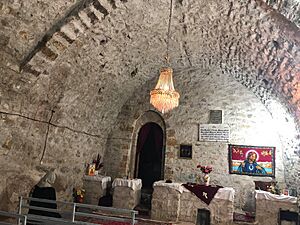
By the 6th century, the Church of the East had spread across many countries to the east and west of the Euphrates River. This included the Sasanian Empire, the Arabian Peninsula, and even parts of India. It also had a presence among the Huns and on islands in the Indian Ocean.
Under Islamic Rule
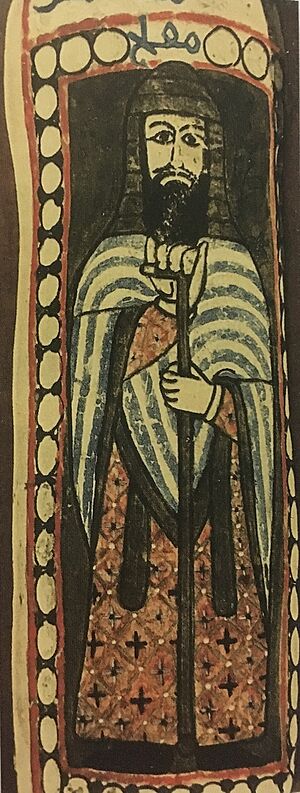
After the Muslim conquest of Persia in 644 AD, the Church of the East became a recognized minority group under the new Islamic rulers. They were called "dhimmi", which meant they had some protection but also some restrictions. For example, they couldn't try to convert Muslims.
However, their missionaries were free to spread their faith elsewhere. They established new churches in India and had great success converting local groups in Central Asia. In China, Nestorian missionaries were well-established during the Tang dynasty (618–907 AD). The famous Nestorian Stele in China describes how Christianity was introduced there in 635 AD.
By the 10th century, the Church of the East had many dioceses (church districts) stretching across the Islamic Caliphate's lands, all the way to India and China. Christians from the Church of the East also made important contributions to Islamic society, especially by translating ancient Greek writings into Syriac and Arabic. Many doctors for the Caliphs were also Christians from this church.
How the Church Expanded
After separating from the Western churches, the Church of the East grew quickly through missionary work. Between 500 and 1400 AD, it spread far beyond its original home in modern-day Iraq, Syria, and Turkey.
Communities appeared across Central Asia. Missionaries from Mesopotamia brought Christianity to China, as shown by the Nestorian Stele from 781 AD. But their most important success was converting the Saint Thomas Christians in Kerala, India. These Christians were one of the few groups to survive the church's decline later on. Today, they are the largest group still using the Church of the East's traditional worship style.
In India
The Saint Thomas Christian community in Kerala, India, has a long history with the Church of the East. They believe their faith was brought by Thomas the Apostle. From at least the 4th century, the Church of the East provided them with clergy and religious texts.
By the 8th century, the community in India became its own church province, led by a metropolitan bishop from Persia. This bishop oversaw other local bishops and a native Archdeacon.
When the Portuguese arrived in India in the 16th century, they tried to bring the Saint Thomas Christians under the authority of the Pope and the Latin Church. This led to a major conflict. In 1599, after the Synod of Diamper, many changes were forced upon them.
This caused a revolt in 1653, known as the Coonan Cross Oath, where many vowed not to submit to the Portuguese. Later, some returned to the Catholic Church, forming the Syro-Malabar Catholic Church. Others joined the Syriac Orthodox Church, becoming the Malankara Church.
In China
Christianity reached China by 635 AD. The Nestorian Stele, set up in 781 AD, tells how a Persian cleric named Alopen introduced Christianity to China during the Tang dynasty. The stele lists the names of many important Christians in China at that time.
Nestorian Christianity thrived in China for about 200 years. However, it faced persecution from Emperor Wuzong of Tang in the 9th century, who suppressed all foreign religions. The church then declined sharply in China and disappeared by the early 10th century.
Christianity saw a comeback in China during the Yuan dynasty (13th century), which was established by the Mongols. Travelers like Marco Polo described many Nestorian communities in China and Mongolia.
In Mongolia and Central Asia
The Church of the East had a final period of growth under the Mongols. Some Mongol tribes had already become Christian in the 7th century. Christianity was a big influence in the Mongol Empire. Even Genghis Khan's sons married Christian women.
During the rule of Möngke Khan, Nestorian Christianity was the main religion in the Mongol Empire and in Mongol-controlled China. This was when the Church of the East reached its largest geographical size. However, the Mongol Empire soon began to weaken and break apart. In 1295, the Mongol ruler Ghazan converted to Islam, which marked a turning point.
In Jerusalem and Cyprus

There was likely a Nestorian presence in Jerusalem around 1300 AD. Records show a clear Nestorian presence at the Holy Sepulchre from 1348 to 1575. A Nestorian community was also established in Famagusta, Cyprus, just before 1300, and a church was built for them around 1339.
Decline of the Church
After its period of expansion, the Church of the East began to decline. In 1000 AD, there were 68 cities with bishops; by 1238, there were only 24. When Timur, a Turco-Mongol leader, came to power in 1370, he severely persecuted non-Muslims, almost wiping out Christianity in Central Asia.
The Church of the East survived mainly in the mountains of Kurdistan and in India. Apart from the Saint Thomas Christians in India, the church was mostly limited to a small area in modern-day northern Iraq, southeast Turkey, northeast Syria, and northwestern Iran.
The disappearance of the church in Central Asia was likely due to persecution, diseases like the Black Death, and isolation. In China, the last mentions of Nestorian Christians are from the 1350s, just before the Ming dynasty took over and isolated China from foreign influences.
Splits in the Church
From the mid-16th century, the Church of the East experienced several internal splits, called schisms. Some groups chose to unite with the Catholic Church, while others were caused by rivalries within the church.
Despite these challenges and persecutions from the Ottoman Empire, the traditional branches of the Church of the East survived. By the 19th century, they became the Assyrian Church of the East. At the same time, the groups that united with the Catholic Church formed the Chaldean Catholic Church.
The Split of 1552
Around the mid-15th century, the Patriarch (leader) of the Church of the East started making the position hereditary, passing it from uncle to nephew. This practice caused problems, as there weren't always suitable heirs.
In 1552, Patriarch Shemon VII Ishoyahb appointed his 12-year-old nephew as his successor. This caused great unhappiness. A group of bishops decided to elect a new patriarch, a monk named Shimun VIII Yohannan Sulaqa.
Since they didn't have a bishop of high enough rank to consecrate him, Sulaqa's supporters sought help from Pope Julius III in Rome. Sulaqa traveled to Rome, made a statement of faith, and was officially recognized by the Pope as "Patriarch of the Church of the Chaldeans of Mosul" in 1553.
This event created a lasting split in the Church of the East. Sulaqa's line became known as the "Shimun" line, which was initially in communion with Rome. The original line, based in Alqosh, continued to oppose union with Rome.
Sulaqa returned to Mesopotamia, but he was later imprisoned and killed in 1555. His successors continued the "Shimun" line. However, over time, this line also reverted to hereditary succession and traditional beliefs, eventually becoming the Assyrian Church of the East.
Different Patriarchal Lines
For a long time, there were two main traditionalist patriarchal lines: the older Eliya line in Alqosh and the newer Shimun line in Qochanis.
Later, a third line, called the Josephite line, was formed when a bishop from Amid converted to the Catholic faith in 1667. He was recognized by Rome as "Patriarch of the Chaldean nation." This line became the only Catholic one at the time.
Coming Together of Lines
By 1804, the Nestorian branch of the Eliya line ended. Most of its followers had already joined the Catholic Church. In 1830, Yohannan Hormizd was finally recognized as the Chaldean Catholic Patriarch of Babylon. This marked the end of the hereditary system within the Chaldean Catholic Church.
This also ended the rivalry between the Eliya and Shimun lines. The Shimun line became the sole leader of the traditionalist Church of the East. In 1976, it officially adopted the name Assyrian Church of the East. Its patriarchate remained hereditary until 1975.
So, the original Church of the East (Eliya line) eventually united with Rome and is now the Chaldean Catholic Church. The original Catholic line (Shimun line) became the Assyrian Church of the East.
See also
- Ancient Church of the East
- Assyrian Genocide
- Chaldean Catholic Church
- Christianity in Eastern Arabia
- Council of Seleucia-Ctesiphon (410)
- Dioceses of the Church of the East after 1552
- Dioceses of the Church of the East to 1318
- Dioceses of the Church of the East, 1318–1552
- List of patriarchs of the Church of the East
- Patriarchs of the Church of the East
- Schism of the Three Chapters
- Synod of Beth Lapat
- Syriac Christianity
- Syriac Orthodox Church


